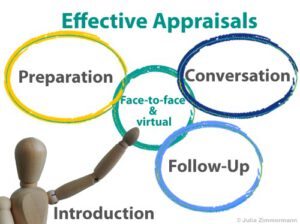How I conducted appraisal conversation to be open and constructive
Part II in the previous week focused on the things to consider as preparation for very effective appraisal processes. Here is the link: I recommend that you read that first if you missed it before you continue here.

The core: Conducting the conversation
This week’s Part III is about how to conduct your annual appraisals conversation itself. To make a feedback conversation in the appraisal process most effective I have to share 9 aspects which I will describe briefly in the following.
1. The setting of the conversation:
For a face-to-face appraisal
Consciously select the best location for your meeting. It could be your office but most often a meeting room might be more suitable. A few key principles are: create a relaxed atmosphere, ensure minimal risk of disturbance, check you are in a soundproof environment and stay away from the work environment of the direct report.
Think about how you arrange the seating. A round table could be ideal but if not available you could sit across the corners of a table or side-by-side on a table. Make sure that you have all your documentation with you when you enter the room and start the conversation.
Special aspects for virtual leaders when setting up the conversation
Consider which communication system will help to reduce the physical distance at least in the perception of your direct report and yourself. Ideally, you would want to have a video connection as well so you can see the body language of the other person. Ensure also that your direct report is not sitting at their desk or in their normal working environment in order to minimize distractions or disturbances of your conversation and keep it confidential.
2. Your mindset to be most effective:
Before you enter into the conversation remember that you only know your view of the world and of those who gave feedback about your direct report (with your interpretation of it). You could miss key elements of how your direct report experienced the year. Hence, keep an open mind and be prepared to shift your perspective. Be first interested in your direct report’s assessment and views of the year. Tune into the conversation with open questions for exploration.
3. Clarify your assessment standards:
When moving into the assessment part of the performance repeat your standards which you consider as the foundation of the performance assessment. Make sure your direct report has a full understanding of what your standards mean.
4. Start with your direct report’s perspective:
Ask your direct report to kick off with reviewing the year from his/her perspective. Whatever he/she covers create always the focus on facts and examples. Always relate his/her perspective of facts and examples to the standards you had set out at the beginning and ask the direct report for his/her evaluation first, based on these standards.
5. Explore the areas of deviations:
In order to make the most out of the feedback conversation I would recommend to spend more time in the areas where you see deviations between your direct report’s and your own point of view. Explore the differences with an open mind primarily to understand, not to convince the direct report of your view. If appropriate, you should be prepared to change your assessment, but not just for the sake of keeping your direct report happy.
6. Alternate between positive and negative aspects:
Most often organisations use either a competency or performance model as a core element of the appraisal format. You could use this as your red line going through the feedback conversation. I would recommend alternating between positive and negative aspects. Don’t go ‘mechanically’ step-by-step through the competencies or performance elements given in the format. Alternating positive and negative helps to create a balance between things which went well and things which need improvement. If you bring too much of negative feedback in one go people tend to shut down and listen less openly. If you bring all negative feedback first and positive at the end they may forget about the negative feedback as they hear a lot of positive feedback towards the end. To start on a good footing I recommend kick-off the conversation with a positive aspect and praise of the person.
Note: At this point all the elements focus on reviewing the year and giving feedback. It could be useful to have this covered in one conversation and plan a second conversation for the forward-looking elements.
7. Development priorities and plan:
Based on all the feedback and insights both of you have gained in the feedback conversation select together two or three development priorities for the coming year. Experience shows that if you go beyond three development priorities focus will be lost throughout the year and the risk increases that nothing will change. It goes without saying that the development areas must be relevant to the job and career prospects of your direct reports and have to be mutually agreed.
You could either co-create a plan for your direct reports development or ask your direct report to create one for discussion putting more ownership into their hands.
8. Goal setting for the next 12 months:
In the cascading process of organisational objectives discuss relevant objectives and goals for the next 12 months. Unfortunately, on numerous occasions I have seen objectives being set for a person which where rather unspecific as well as abstract, and in addition, the person himself could not see any way of influencing the outcome of these objectives. I highly recommend that you take the time with your direct report to break down higher level objectives in such a way that they are relevant, attractive, and can be influenced by your direct report. When considering to cascade elements of your own objectives think about how you could frame these elements so that you touch your direct report’s intrinsic motivators.
Of course some organisations operate such a dynamic environment that a 12 month period is far too long to set targets. Adjust appropriately and set the review at the end of the agreed periods instead of annually. If you run your organisation more on a project based rhythm setting targets per project and reviews them a the end of that project might as well be a very good alternative.
9. Documentation:
When you’ve conducted all the assessments, the forward planning, and goal setting, do document all these elements well. Make sure your direct reports understand what they mean for him/her. Depending on your organisation you may anyhow be asked to do this documentation, may be using a company internal system. Agree who is responsible for what in the plan. The emphasis should be on the direct reports responsibility for the plan. The key point here is clearly to ensure that both of you have that mutual understanding of the review and the way forward.
Summary: Key points for the effective conduct
1) Consciously take care of the settings for your conversation
2) Keep an open mind and use open questions for exploration
3) Clarify your standards of performance assessment and check understanding
4) Explore your direct reports perspective first (applying your assessment standards)
5) Focus on deviations between your direct report’s view versus the collected feedback and your own perspective
6) Have a sequence of positive and negative points alternating between them
7) Agree on only two or three development priorities and co-create a plan to achieve these
8) Set clear and relevant, motivating goals for the next 12 months
9) Document the feedback plans and goals and ensure mutual understanding, agree responsibilities
Part IV, the final part of the blog series about an effective appraisal process, will concentrate on Follow-Up and Continuous Feedback. It is the one which is neglected most often, even though, in my view, it is vital for your direct report’s development and important to make your appraisal conversation easy. It will be published next week.
So, if you’re interested in a more in-depth conversation about your particular challenge, please .
Or feel free to share your thoughts in the comments section below.
Thank you very much for your interest.



